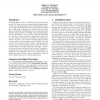Free Online Productivity Tools
i2Speak
i2Symbol
i2OCR
iTex2Img
iWeb2Print
iWeb2Shot
i2Type
iPdf2Split
iPdf2Merge
i2Bopomofo
i2Arabic
i2Style
i2Image
i2PDF
iLatex2Rtf
Sci2ools
102
click to vote
CCS
2006
ACM
2006
ACM
Hot or not: revealing hidden services by their clock skew
Location-hidden services, as offered by anonymity systems such as Tor, allow servers to be operated under a pseudonym. As Tor is an overlay network, servers hosting hidden services are accessible both directly and over the anonymous channel. Traffic patterns through one channel have observable effects on the other, thus allowing a service's pseudonymous identity and IP address to be linked. One proposed solution to this vulnerability is for Tor nodes to provide fixed quality of service to each connection, regardless of other traffic, thus reducing capacity but resisting such interference attacks. However, even if each connection does not influence the others, total throughput would still affect the load on the CPU, and thus its heat output. Unfortunately for anonymity, the result of temperature on clock skew can be remotely detected through observing timestamps. This attack works because existing abstract models of anonymitynetwork nodes do not take into account the inevitable im...
| Added | 20 Aug 2010 |
| Updated | 20 Aug 2010 |
| Type | Conference |
| Year | 2006 |
| Where | CCS |
| Authors | Steven J. Murdoch |
Comments (0)

